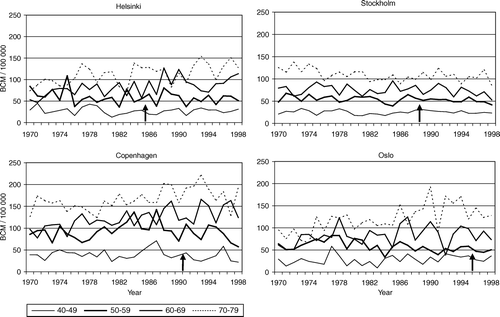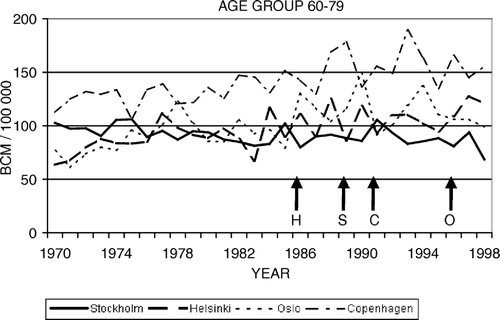Abstract
The aim of the present study was to relate the time trends in breast cancer incidence and mortality to the introduction of mammography screening in the Nordic capitals. Helsinki offered screening to women aged 50–59 starting in 1986. The other three capitals offered screening to women aged 50–69 starting in 1989 in Stockholm, 1991 in Copenhagen, and 1996 in Oslo. Prevalence peaks in breast cancer incidence depended on the age groups covered by the screening, the length of the implementation of screening, and the extent of background opportunistic screening. No mortality reduction following the introduction of screening was visible after seven to 12 years of screening in any of the three capitals where significant effects of the screening on the breast cancer mortality had already been demonstrated by using other analytical methods for the evaluation. No visible effect on mortality reduction was expected in Oslo due to too short an observation period. The study showed that the population-based breast cancer mortality trend is too crude a measure to detect the effect of screening on breast cancer mortality during the first years after the start of a programme.
The effect of mammography screening on breast cancer mortality has been studied in several randomised trials the majority of which have been performed in Sweden Citation[1–4]. These studies have shown that it is possible to reduce breast cancer mortality by 20–30% at a population level. In an update of four Swedish trials with a follow-up of 16 years, the mortality reduction was 21% Citation[5], and in a 20-year follow-up of the two-county trial a greater than 40% reduction in breast cancer mortality was found Citation[6]. National guidelines and recommendations for mammography screening, as well as European Guidelines from the European Commission Citation[7], have been issued and have influenced the establishment and organisation of mammography screening as well as the treatment of breast cancer patients. Nationwide screening programmes now exist in Finland, Iceland, Luxembourg, the Netherlands, Sweden, and the UK. Other European countries such as Ireland, France, Italy, Spain and Germany have started to build up national programmes. Finland and Sweden have had service screening since 1986–1987, whereas two programmes in Denmark, one covering the municipalities of Copenhagen and Frederiksberg, and one in the county of Funen, were initiated in 1991 and 1993, respectively. The Norwegian Breast Cancer Screening Programme started in 1996 in four counties, including one in Oslo, and became nationwide in 2004.
The Europe Against Cancer programme (EAC) was initiated by the European Commission in 1985, and pilot screening programmes started in a number of countries that did not have organised breast cancer screening at the time. The breast cancer screening activities within the EAC programme were compiled in a network that facilitated the sharing of experiences with the aim of organising optimal breast screening in the EU countries Citation[8]. The European Commission has therefore recommended studies on the impact of screening Citation[9], Citation[10]. In many of these countries, the screening programmes have now been running for almost a decade, and there is considerable interest in evaluating the effect of these non-randomised service screening activities on breast cancer mortality.
The Nordic countries are similar in terms of their health care systems and, in contrast to the situation in most European countries, they have a long tradition of national registers for population, cancer incidence, and causes of death. Methods for estimating the effectiveness of the service mammography screening programmes have also been developed within the Nordic countries, and a number of studies have demonstrated an effect of population-based routine service screening Citation[11–15].
The aim of the present study was to find out if the decrease in breast cancer mortality in relation to the availability of population-based breast cancer screening programmes, already described in studies from Helsinki, Stockholm, and Copenhagen, would also be possible to demonstrate by using routine, easily accessible statistics.
Material and methods
Data on population size, screening start, screening programme coverage, age groups invited, screening interval, and existence of standardised protocols for assessment and treatment were collected from the screening centres in Copenhagen and Stockholm, and from the Cancer Registries in Finland and Norway (). Data were also collected on number of women, number of incident breast cancer cases, number of screen-detected invasive cancers and DCIS, and number of deaths with breast cancer as the underlying cause of death for each year during the period 1970–1998 for women aged 40–79 years by 5-year age groups. Number of incident breast cancers was defined as those annually reported to the Cancer Register, ICD-7 code 170 (International Classification of Diseases and Causes of Death, 7th edition) and malignancy (behaviour) code 3 (invasive disease). Data on the coverage of the target population during the building-up phase of the screening programme, and the number of women screened within the programme were also collected.
Table I. Description of the mammography screening programmes in the Nordic capitals.
Helsinki
Helsinki is the largest municipality in Finland with a population of more than 0.5 million, representing 10% of the national population (). The breast cancer screening programme started in Helsinki in 1986, and was introduced gradually Citation[16]. The programme targets women aged 50 to 59 years. Personal invitations to mammography screening with a defined appointment time are sent to women drawn from the population register. Women reaching the age of 50, 52, 54, 56, or 58 years in a given calendar year are invited (). During the period1986–1989 the screening programme was run by the breast cancer screening centre of the Finnish Cancer Society. From 1989 and onwards it has been organised by the city health department. Only one screening centre is used, and it is located in the Laakso Hospital in central Helsinki. There was a seven-year implementation period and the first round was not completed for the whole target age group until 1993. The average attendance rate has been 82%, varying annually from 79% to 84% (). Around 5 per 1 000 examined women had a cancer diagnosed, including DCIS ().
Figure 1. Description of target population during building-up phase of screening in the four capitals. In Helsinki different birth cohorts were successively invited starting in 1986 and the total target population between 50 and 59 years was included in the program from 1994 onwards. Copenhagen and Oslo updated the target population on a biannual basis except for the two first rounds in Copenhagen where women up to 74 years of age were invited to screening. In Stockholm, the target population was updated on a weekly basis.

Figure 2. Number of screened women per 1 000 of the target group in age group 50–69 (50–59 for Helsinki) per year. Helsinki completed the implementation in 1994, and thereafter the number of screened women per 1 000 women in the target population was also used as indicator of screening coverage and attendance. With a screening interval of two years, 500 screened women per 1 000 per year equals 100% attendance (right vertical axis).
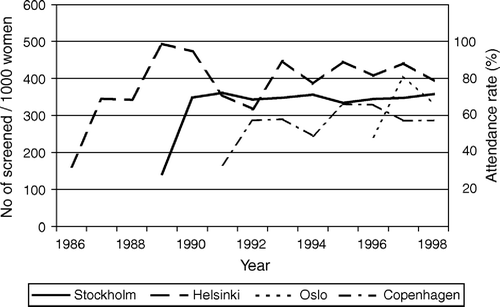
Figure 3. Number of screen detected cancers (SDC), (invasive + DCIS) per 1 000 screened women in age group 50–69 (50–59 for Helsinki) per year.
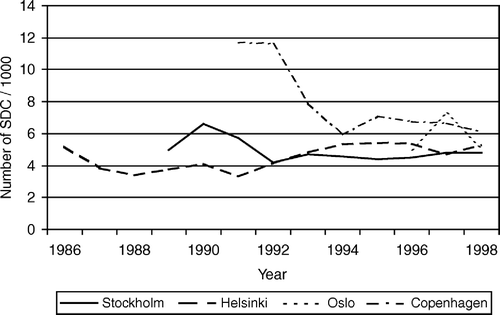
Screening is not possible outside the screening programme. Diagnostic mammography requires a referral from a physician and is undertaken only when there are medical or clinical indications. However, no data are available on the extent of opportunistic mammography.
Stockholm
The Stockholm mammography-screening programme was initiated in August 1989, and by March 1992 all women had been invited to their first round ( and ). The programme covers all of Stockholm County and has five fixed units Citation[17]. Women aged 50 to 69 are invited and they are included during the year they turn 50. The women are excluded from the invitation database the year they turn 70. One of the units, covering approximately 25% of the population, ran the Stockholm trial between 1981 and 1989 and was converted into a routine screening service starting in 1989. Women are invited by a personal letter with a defined appointment time, which is possible to re-book. A reminder letter is sent three months later to non-participating women. The attendance rate has been around 70–75% (). The cancer detection rate over the years, including DCIS, has been approximately 4 per 1 000 screened women (). Screening outside the programme requires a referral. Seven private clinics perform mammography, none of which is included in the organised screening programme. Women from the screening units are assessed and treated by a team at one of five defined hospitals. Treatment is guided by care programmes, i.e. regional protocols guiding diagnostic procedure, treatment, follow-up and terminal care that are written, updated and approved by experts in the field. The purpose of the care programme is to ensure optimal treatment and care for all cancer patients, irrespective of place of residence.
Copenhagen
The first mammography-screening programme in Denmark started in the municipality of Copenhagen in April 1991 (). In June 1994 a second programme started in the small municipality of Frederiksberg, which is located geographically within the municipality of Copenhagen. The two programmes were merged in 1996, and data for both municipalities are included in this paper. The programme targets women aged 50 to 69 at the start of each invitation round. The municipalities of Copenhagen and Frederiksberg have about 40 000 and 10 000 female residents aged 50–69 respectively. Screening is offered biennially to all women in the target group, and a personal invitation letter with a defined appointment time is sent to each woman. The second and third invitation rounds for Frederiksberg were prolonged so that starting in April 2001, the invitation rounds in the two municipalities have run simultaneously. Screening takes place at a special clinic at Bispebjerg Hospital, and since September 1st, 1996, all further assessment and surgery takes place at Rigshospitalet. Around 300 per 1 000 women in the target group are examined per year (a participation rate of approximately 60%, ). It should be noted that for the period 1991–1993 the figure represents a combination of participation in Copenhagen and Frederiksberg, despite the fact that women in Frederiksberg were not invited until 1994. The cancer detection rate including DCIS has been 6 per 1 000 screened women, except for the first round when it exceeded 11 per 1 000 () Citation[18]. Mammography examination outside the organised programme requires a referral from a general practitioner and, in principle, it is provided only to symptomatic women. It is also possible for a woman to have mammography at a private clinic. The extent of this activity is, however, negligible Citation[19].
Oslo
Oslo has a population of about 0.5 million, constituting 11% of the Norwegian population. The screening programme in Oslo started in 1996 as part of a pilot project. The first screening round was completed in 1997. After the pilot project was finished in 1999 it was converted into service screening ( and ). Women aged 50 to 69 are invited by a personal letter with a defined appointment time that is possible to re-book. A reminder is sent one to three months later to non-participating women. The fee for a screening mammogram is around 15 € and covers the screening examination and expenses for any further diagnostic assessments. The organisation of the Oslo screening programme is highly centralised, with one screening unit. The diagnostic work-up is undertaken at the breast clinic at Ullevål University Hospital. Between 300 and 400 women per 1 000 population are examined per year, giving an average attendance of approximately 70% (). The cancer detection rate, including DCIS, has varied during the building-up phase and has been around 5 to 6 per 1 000 () Citation[20]. The extent to which women aged 50–69 use mammography screening at private institutes in Oslo is not documented and is therefore unknown.
Analysis
Aggregated data on breast cancer incidence and mortality per year between 1970 and 1997 in 5-year age groups were collected from each of the four capitals. Information on start of screening, proportion of target population included in the programme, and the number of women invited and examined per year in different age groups was also collected. Breast cancer incidence and mortality rates were estimated as the number of breast cancers or deaths from breast cancer divided by the number of women. The trends were related to the extent of the service mammography screening.
Results
The introduction of mammography screening was rapid in Stockholm and Oslo, stepwise in Copenhagen, where the municipality of Frederiksberg was only included from 1994 onwards, and slow in Helsinki where only separate cohorts aged 50 to 59 were invited in the beginning. Each year around 30 to 40% of the target populations were examined, giving an estimated average attendance in the four capitals of between 60 and 80% during a 24-month period (). The rate of screen-detected cancer was highest in Copenhagen at 6/1 000 on average, but at more than 11/1 000 during the first round ().
The proportion of cancers detected at screening stabilised at 50–60% after the first round, except in Helsinki where the screen detected cancers constituted 70–80% of all cancers (). It should however, be noted that the patterns in and reflect a mixture of detection rates for initial and subsequent screening.
Figure 4. Screen detected cancers (SDC), (invasive + DCIS) as the proportion of all diagnosed breast cancers (invasive only) in age group 50–69 (50–59 for Helsinki) per year.
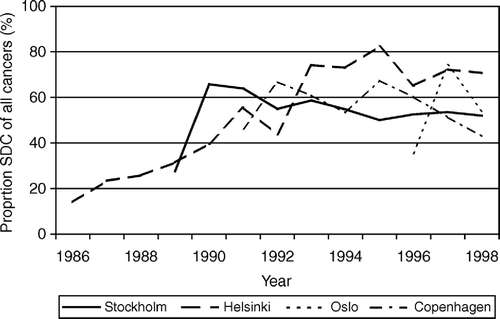
Breast cancer incidence increased continuously in all four capitals (). Prevalence peaks were particularly visible for women aged 50–59 and 60–69 in Copenhagen, Stockholm, and Oslo. As expected, the peaks were higher in age group 60–69 than in age group 50–59. No clear prevalence peak occurred in Helsinki for women aged 50–59 who were targeted by the programme ( and ). A peak in the incidence was, however, seen towards the end of our observation period for women aged 40–49 in Helsinki.
Figure 5. Breast cancer incidence (BCI) per 100 000 in Helsinki, Stockholm, Copenhagen, and Oslo in age groups 40–49, 50–59, 60–69, and 70–79. Arrows indicate start of screening.
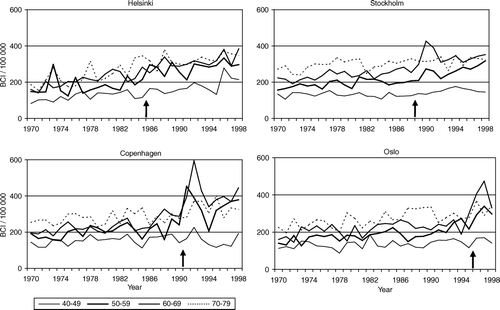
Copenhagen had higher breast cancer mortality in all age groups than the other three capitals (). There was no pronounced decrease in the trend of breast cancer mortality in any age group during the studied time period in any of the four capitals ( and ). The size of the Stockholm population was four times larger than that of Helsinki, Copenhagen and Oslo, thereby making the mortality curve more stable.
Discussion
A substantial increase in breast cancer incidence rates was observed at the time screening was introduced in three of the four capitals. This was obviously due to identification of cancers in the detectable pre-clinical phase at the first round, sometimes called the prevalence peak. It cannot be taken as an indication of the effectiveness of screening as it only confirms the intense start of the screening programmes.
Copenhagen had no opportunistic screening prior to initiation of the organised programme in 1991, which was therefore followed by pronounced prevalence peaks in the screened age groups. This lack of widespread diagnostic activity before screening started in Copenhagen could also be an explanation for the rather high cancer detection rate during the initial screening. Prevalence peaks were also seen following the introduction of screening in Stockholm and Oslo, but these were less pronounced than in Copenhagen. In Stockholm there was a small peak in the age group 50–59 in the early 1980s which was probably due to the Stockholm randomised mammography screening trial Citation[3]. It should be taken into account here that 20% of the women in Stockholm had previously been covered by that trial. The lack of a prevalence peak in the age group 50–59 in Helsinki is probably due to the prolonged building up of the Finnish programme and the fact that the incidence rate during that period was a mixture of both initial screening and subsequent screening. However, prevalence screening after the prevalent round, i.e. in women turning 50 and women moving into the region, accounted for less than 10% of the cases in Stockholm, and Oslo. The capital Copenhagen was constituted by the two municipalities, Copenhagen and Frederiksberg. Frederiksberg started screening three years later than the municipality of Copenhagen, resulting in both a second prevalence peak, visible in , and a higher proportion of women being invited to initial screening over a longer period in time in comparison to Stockholm and Oslo. The more moderate prevalence peaks in the screening ages in Stockholm and in Oslo could be due to more widespread spontaneous screening in both capitals before the organised screening programme started. The size of the prevalence peak can thus vary considerably between programmes, and this is an important factor to take into account in planning for treatment capacity during the introduction of a screening programme. The breast cancer detection rates were, however, at similar levels in all four capitals during incident rounds, despite the fact that only women between 50 and 59 were targeted in Helsinki.
However, a prospective registration of breast cancer cases before the start of organised screening in Oslo showed that the proportion of pT1 tumours and the proportion of cases with involved axillary lymph nodes were unchanged in this period Citation[21], which means that opportunistic screening did not shift the stage distribution and is therefore unlikely to have affected the breast cancer mortality.
There was a large increase in breast cancer incidence within the non-invited age group 40–49 years in Helsinki (). This could be due to an increase in diagnostic activity outside the screening programme, but it could also be due in part to the pronounced cohort trend in breast cancer incidence in Finland Citation[22].
The potential impact of the screening programme on breast cancer mortality will depend on the proportion of breast cancers detected at screening. For Helsinki, after the building-up phase was completed about 70% of all breast cancers in age group 50–59 were detected within the screening programme. In the three other capitals about 60% of the breast cancers in women aged 50–69 were detected in the programmes. This difference is expected, as Helsinki had the highest participation rate of the four capitals.
Even after the introduction of screening a certain proportion of the target age groups will be unscreened while they await invitation or because they have chosen not to participate. Breast cancers among these women will be treated according to the protocols implemented in the Nordic countries before screening was introduced. It is, however, likely that non-screened breast cancer patients will also benefit from screening related changes in the clinical practice, e.g. the introduction of multi-disciplinary diagnostic teams.
There was no visible reduction in breast cancer mortality after start of screening in any of the four programmes. This does not imply that the programmes were ineffective. It is reasonable to believe that a majority of women dying of breast cancer after the start of the screening programme would have had their breast cancer diagnosed several years before the screening programme was initiated (refined mortality). An explanation for the lack of visible effect would therefore instead be the long lag between time of diagnosis and time of death in breast cancer patients even without screening. For Helsinki, the absence of a visible decrease in breast cancer mortality could also be explained by the long building-up phase and for Oslo by the short observation time. Recently, studies from Finland, Italy, the Netherlands, Sweden, the UK, and Denmark have demonstrated a decrease in breast cancer mortality following the introduction of service mammography screening Citation[11–15], Citation[23–26]. These studies have used more sophisticated methodologies which are not applicable in all countries. The Helsinki programme started in 1986 and is the oldest of the Nordic capital programmes, but it was introduced gradually and it was not until 1993 that all women aged 50–59 were targeted by the programme. Using refined mortality data and comparing the invited and non-invited birth cohorts Anttila et al. Citation[16] demonstrated a 19% reduction in breast cancer mortality following introduction of the Helsinki programme. The Stockholm programme was introduced by inviting the entire target group of women aged 50 to 69 over a time period equalling a screening interval, i.e. 24 months. It has therefore not been possible to evaluate the Stockholm programme using the Finnish design. However, in a study by Jonsson et al. Citation[13] it was demonstrated that service screening had had an effect on breast cancer mortality when counties, including Stockholm county, that introduced screening in the 1980s were compared with counties that introduced screening in the 1990s. Hence, despite the fact that an effect of service screening on breast cancer mortality was seen when the refined mortality was analysed, no decrease was seen in the population-based rates of all breast cancer deaths analysed here ().
Ideally, evaluation of service screening requires access to nationwide data on population, cancer incidence, causes of death, and screening programme data, and linkage of such data at an individual level. In the absence of such data at the individual level, modelling of aggregated data is the standard solution. But if the screening effect is not larger than the other effects, plus the random variation, then the effect of screening will be masked in this type of analysis.
Our study did not provide evidence for the feasibility of evaluating the countries in the EAC programme for effectiveness by means of routine mortality data. Despite a rather long observation period, at least for Stockholm and Helsinki, we found the population-based mortality trends to be too crude a method for detection of an otherwise documented effect of screening on breast cancer mortality in the Nordic countries. While the EU council recommendations Citation[10] emphasise the need for evaluation in general, they do not give specific advice regarding design and analysis when evaluating effectiveness in terms of effect on mortality, nor do other documents Citation[7]. The most immediate method, a before-after comparison of routine mortality data, is likely to result in a conservative estimate of no effect, which should therefore be interpreted with caution.
This research project was supported by funding from the Europe Against Cancer programme of the European Commission within the European Breast Cancer Network (Budget contract 2000, SI2.307923). We are indebted to Drs Helene Grundström, Gunilla Svane, Karin Leifland, Kerstin Moberg, Tor Sahlstedt and to all staff at the five participating mammography screening units in the Stockholm region, and to Drs Anka Ertzaas and Steinar Thoresen and the staff at the Oslo screening programme, Cancer Registry of Norway.
References
- Tabar L, Fagerberg CJ, Gad A, Baldetorp L, Holmberg LH, Grontoft O, et al. Reduction in mortality from breast cancer after mass screening with mammography. Randomised trial from the Breast Cancer Screening Working Group of the Swedish National Board of Health and Welfare. Lancet 1985; 1(8433)829–32
- Andersson I, Aspegren K, Janzon L, Landberg T, Lindholm K, Linell F, et al. Mammographic screening and mortality from breast cancer: the Malmö mammographic screening trial. BMJ 1988; 297: 943–8
- Frisell J, Eklund G, Hellström L, Lidbrink E, Rutqvist L-E, Somell A. Randomized study of mammography screening - preliminary report on mortality in the Stockholm trial. Breast Cancer Res Treat 1991; 18: 49–56
- Bjurstam N, Bjorneld L, Warwick J, Sala E, Duffy SW, Nystrom L, et al. The Gothenburg Breast Screening Trial. Cancer 2003; 97(10)2387–96
- Nystrom L, Andersson I, Bjurstam N, Frisell J, Nordenskjold B, Rutqvist LE. Long-term effects of mammography screening: updated overview of the Swedish randomised trials. Lancet 2002; 359(9310)909–19
- Tabar L, Yen MF, Vitak B, Chen HH, Smith RA, Duffy SW. Mammography service screening and mortality in breast cancer patients: 20-year follow-up before and after introduction of screening. Lancet 2003; 361(9367)1405–10
- N Perry, Broeders, M, de Wolf, C, Törnberg, S, editors. European Guidelines for Quality Assurance in Mammography Screening. Third edition. Luxembourg: Europe Against Cancer, European Commission; 2001.
- de Waard F, Kirkpatrick A, Perry NM, Tornberg S, Tubiana M, de Wolf C. Breast cancer screening in the framework of the Europe against Cancer programme. Eur J Cancer Prev 1994; 3 Suppl 1: 3–5
- Recommendations on cancer screening in the European union. Advisory Committee on Cancer Prevention. Eur J Cancer 2000; 36(12)1473–8
- Council of the European Union. Council Recommendation of 2 Dec 2003 on cancer screening 2003/87/EC. Official J European Union 2003: 16.2.2003: L327/34–L327/38.
- Törnberg S, Carstensen J, Hakulinen T, Lenner P, Hatschek T, Lundgren B. Evaluation of the effect on breast cancer mortality of population based mammography screening programmes. J Med Screen 1994; 1: 184–7
- Hakama M, Pukkala E, Heikkila M, Kallio M. Effectiveness of the public health policy for breast cancer screening in Finland: population based cohort study [see comments]. BMJ 1997; 314(7084)864–7
- Jonsson H, Nystrom L, Tornberg S, Lenner P. Service screening with mammography of women aged 50-69 years in Sweden: effects on mortality from breast cancer. J Med Screen 2001; 8(3)152–60
- Duffy SW, Tabar L, Chen HH, Holmqvist M, Yen MF, Abdsalah S, et al. The impact of organized mammography service screening on breast carcinoma mortality in seven Swedish counties. Cancer 2002; 95(3)458–69
- Olsen AH, Njor SH, Vejborg I, Schwartz W, Dalgaard P, Jensen MB, et al. Breast cancer mortality in Copenhagen after introduction of mammography screening: cohort study. BMJ 2005; 330(7485)220
- Anttila A, Koskela J, Hakama M. Programme sensitivity and effectiveness of mammography service screening in Helsinki, Finland. J Med Screen 2002; 9(4)153–8
- Lidbrink EK, Tornberg SA, Azavedo EM, Frisell JO, Hjalmar ML, Leifland KS, et al. The general mammography screening program in Stockholm. Organisation and first-round results. Acta Oncol 1994; 33(4)353–8
- Vejborg I, Olsen AH, Jensen MB, Rank F, Tange UB, Lynge E. Early outcome of mammography screening in Copenhagen 1991–99. J Med Screen 2002; 9(3)115–9
- Jensen A, Olsen AH, von Euler-Chelpin M, Helle Njor S, Vejborg I, Lynge E. Do nonattenders in mammography screening programmes seek mammography elsewhere?. Int J Cancer 2005; 113(3)464–70
- Wang H, Karesen R, Hervik A, Thoresen SO. Mammography screening in Norway: results from the first screening round in four counties and cost-effectiveness of a modeled nationwide screening. Cancer Causes Control 2001; 12(1)39–45
- Karesen, R, Jacobsen, U, Sauer, T, Skaane, P. [A prospective registration of diagnosis and treatment of breast tumors at the Ulleval hospital 1988-1995]. Tidsskr Nor Laegeforen 1999;119(24):3562–6, (in Norwegian).
- Rostgaard K, Vaeth M, Holst H, Madsen M, Lynge E. Age-period-cohort modelling of breast cancer incidence in the Nordic countries. Stat Med 2001; 20(1)47–61
- Blanks RG, Moss SM, Patnick J. Results from the UK NHS breast screening programme 1994–1999. J Med Screen 2000; 7(4)195–8
- Otto SJ, Fracheboud J, Looman CW, Broeders MJ, Boer R, Hendriks JH, et al. Initiation of population-based mammography screening in Dutch municipalities and effect on breast-cancer mortality: a systematic review. Lancet 2003; 361(9367)1411–7
- Paci E, Giorgi D, Bianchi S, Vezzosi V, Zappa M, Crocetti E, et al. Assessment of the early impact of the population-based breast cancer screening programme in Florence (Italy) using mortality and surrogate measures. Eur J Cancer 2002; 38(4)568–73
- Paci E, Duffy SW, Giorgi D, Zappa M, Crocetti E, Vezzosi V, et al. Quantification of the effect of mammographic screening on fatal breast cancers: The Florence Programme 1990–96. Br J Cancer 2002; 87(1)65–9
